If you still haven’t figured out how to properly cook pasta, this recipe is for you. Cacio e pepe translates to “cheese and pepper” — and that is about all you will need for this recipe. Though I might be biased, I would say that this recipe is even better than the sauce they sell at Trader Joe’s.
Cook time: 15 minutes
Serving size: 2-3 servings
Ingredients:
Spaghetti
Solid pecorino romano
High quality olive oil
Fresh ground black peppercorns
Steps:
- Cook your spaghetti to al dente. (In beginner’s terms, you want it to be cooked, but just have a little bit of a bite to it, so don’t leave it in the water for too long.)
- While it’s cooking, thinly grate up a cup or so of your cheese.
- Fun tip: if you get a solid cheese piece, you can cut off a piece of the rind, put it in your pasta water while it’s cooking to infuse the cheese taste into the pasta. It’s a fun way to incorporate something that would have otherwise been a scrap!
- Grab a bowl, add your cheese and a bunch of pepper — if you think it’s enough keep adding more.
- Drain the pasta but keep a couple of cups of the pasta water to the side.
- Add a little bit of olive oil to the pot that the spaghetti is in to keep it from sticking to each other and put it to the side.
- Start heating up a saucepan at a low heat with a thin layer of olive oil as the base and add in a healthy serving of pepper. We’re trying to infuse the olive oil with the pepper flavor here.
- Add in equal parts water to the bowl of the pecorino/pepper mixture (err on the side of too little) and whisk it very thoroughly.
- You don’t want any graininess in the cheese; it should now be a creamy texture. If it’s still grainy after you mix it, add in a little more water. You have to do this while the pasta water is still hot (not boiling, but still warm).
- Add the pasta to the pan and add some more pasta water. Mix until the pasta water evaporates.
- Take off the stove and add in the cheese mix, and mix thoroughly.
- Enjoy!
If you’re in a pinch, you can use parm instead of the pecorino romano. They’re both similar, but the pecorino is a little creamier and saltier, so it makes for a better pasta. Overall, the key is high quality ingredients — you taste what you pay for especially in the cheese and a little bit in the olive oil! Good luck cooking, Highlanders. Ciao!








